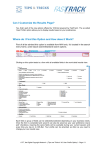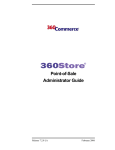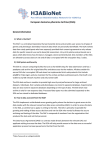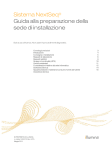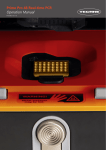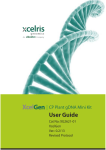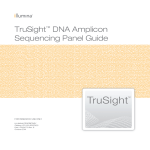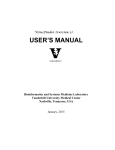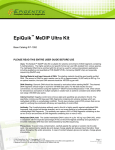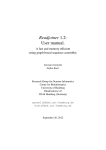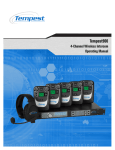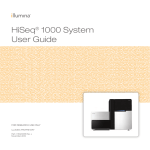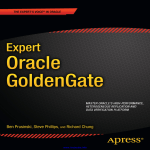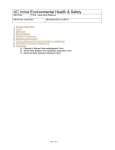Download Illumina FTS Long Reads Pipeline Quick Reference Guide
Transcript
FastTrack Services
Long Reads Pipeline User Guide
FOR RESEARCH USE ONLY
ILLUMINA PROPRIETARY
Part # 15047621 Rev. A
November 2013
This document and its contents are proprietary to Illumina, Inc. and its affiliates ("Illumina"), and are intended solely for the
contractual use of its customer in connection with the use of the product(s) described herein and for no other purpose. This
document and its contents shall not be used or distributed for any other purpose and/or otherwise communicated, disclosed,
or reproduced in any way whatsoever without the prior written consent of Illumina. Illumina does not convey any license
under its patent, trademark, copyright, or common-law rights nor similar rights of any third parties by this document.
The instructions in this document must be strictly and explicitly followed by qualified and properly trained personnel in order
to ensure the proper and safe use of the product(s) described herein. All of the contents of this document must be fully read
and understood prior to using such product(s).
FAILURE TO COMPLETELY READ AND EXPLICITLY FOLLOW ALL OF THE INSTRUCTIONS CONTAINED HEREIN
MAY RESULT IN DAMAGE TO THE PRODUCT(S), INJURY TO PERSONS, INCLUDING TO USERS OR OTHERS, AND
DAMAGE TO OTHER PROPERTY.
ILLUMINA DOES NOT ASSUME ANY LIABILITY ARISING OUT OF THE IMPROPER USE OF THE PRODUCT(S)
DESCRIBED HEREIN (INCLUDING PARTS THEREOF OR SOFTWARE) OR ANY USE OF SUCH PRODUCT(S) OUTSIDE
THE SCOPE OF THE EXPRESS WRITTEN LICENSES OR PERMISSIONS GRANTED BY ILLUMINA IN CONNECTION
WITH CUSTOMER'S ACQUISITION OF SUCH PRODUCT(S).
© 2013 Illumina, Inc. All rights reserved.
Illumina, IlluminaDx, BaseSpace, BeadArray, BeadXpress, cBot, CSPro, DASL, DesignStudio, Eco, GAIIx, Genetic
Energy, Genome Analyzer, GenomeStudio, GoldenGate, HiScan, HiSeq, Infinium, iSelect, MiSeq, Nextera, NuPCR,
SeqMonitor, Solexa, TruSeq, TruSight, VeraCode, the pumpkin orange color, and the Genetic Energy streaming bases
design are trademarks or registered trademarks of Illumina, Inc. All other brands and names contained herein are the property
of their respective owners.
Read Before Using this Product
This Product, and its use and disposition, is subject to the following terms and conditions. If Purchaser does not agree to these
terms and conditions then Purchaser is not authorized by Illumina to use this Product and Purchaser must not use this Product.
1
Definitions. "Application Specific IP" means Illumina owned or controlled intellectual property rights that pertain to
this Product (and use thereof) only with regard to specific field(s) or specific application(s). Application Specific IP
excludes all Illumina owned or controlled intellectual property that cover aspects or features of this Product (or use
thereof) that are common to this Product in all possible applications and all possible fields of use (the "Core IP").
Application Specific IP and Core IP are separate, non-overlapping, subsets of all Illumina owned or controlled intellectual
property. By way of non-limiting example, Illumina intellectual property rights for specific diagnostic methods, for
specific forensic methods, or for specific nucleic acid biomarkers, sequences, or combinations of biomarkers or
sequences are examples of Application Specific IP. "Consumable(s)" means Illumina branded reagents and consumable
items that are intended by Illumina for use with, and are to be consumed through the use of, Hardware.
"Documentation" means Illumina's user manual for this Product, including without limitation, package inserts, and any
other documentation that accompany this Product or that are referenced by the Product or in the packaging for the Product
in effect on the date of shipment from Illumina. Documentation includes this document. "Hardware" means Illumina
branded instruments, accessories or peripherals. "Illumina" means Illumina, Inc. or an Illumina affiliate, as applicable.
"Product" means the product that this document accompanies (e.g., Hardware, Consumables, or Software). "Purchaser"
is the person or entity that rightfully and legally acquires this Product from Illumina or an Illumina authorized dealer.
"Software" means Illumina branded software (e.g., Hardware operating software, data analysis software). All Software is
licensed and not sold and may be subject to additional terms found in the Software's end user license agreement.
"Specifications" means Illumina's written specifications for this Product in effect on the date that the Product ships from
Illumina.
2
Research Use Only Rights. Subject to these terms and conditions and unless otherwise agreed upon in writing by an
officer of Illumina, Purchaser is granted only a non-exclusive, non-transferable, personal, non-sublicensable right under
Illumina's Core IP, in existence on the date that this Product ships from Illumina, solely to use this Product in Purchaser's
facility for Purchaser's internal research purposes (which includes research services provided to third parties) and solely
in accordance with this Product's Documentation, but specifically excluding any use that (a) would require rights or a
license from Illumina to Application Specific IP, (b) is a re-use of a previously used Consumable, (c) is the disassembling,
reverse-engineering, reverse-compiling, or reverse-assembling of this Product, (d) is the separation, extraction, or
isolation of components of this Product or other unauthorized analysis of this Product, (e) gains access to or determines
the methods of operation of this Product, (f) is the use of non-Illumina reagent/consumables with Illumina's Hardware
(does not apply if the Specifications or Documentation state otherwise), or (g) is the transfer to a third-party of, or sublicensing of, Software or any third-party software. All Software, whether provided separately, installed on, or embedded
in a Product, is licensed to Purchaser and not sold. Except as expressly stated in this Section, no right or license under
any of Illumina's intellectual property rights is or are granted expressly, by implication, or by estoppel.
Purchaser is solely responsible for determining whether Purchaser has all intellectual property rights that are
necessary for Purchaser's intended uses of this Product, including without limitation, any rights from third
parties or rights to Application Specific IP. Illumina makes no guarantee or warranty that purchaser's specific
intended uses will not infringe the intellectual property rights of a third party or Application Specific IP.
ii
Part # 15047621 Rev. A
3
Regulatory. This Product has not been approved, cleared, or licensed by the United States Food and Drug
Administration or any other regulatory entity whether foreign or domestic for any specific intended use, whether
research, commercial, diagnostic, or otherwise. This Product is labeled For Research Use Only. Purchaser must ensure it
has any regulatory approvals that are necessary for Purchaser's intended uses of this Product.
4
Unauthorized Uses. Purchaser agrees: (a) to use each Consumable only one time, and (b) to use only Illumina
consumables/reagents with Illumina Hardware. The limitations in (a)-(b) do not apply if the Documentation or
Specifications for this Product state otherwise. Purchaser agrees not to, nor authorize any third party to, engage in any of
the following activities: (i) disassemble, reverse-engineer, reverse-compile, or reverse-assemble the Product, (ii) separate,
extract, or isolate components of this Product or subject this Product or components thereof to any analysis not expressly
authorized in this Product's Documentation, (iii) gain access to or attempt to determine the methods of operation of this
Product, or (iv) transfer to a third-party, or grant a sublicense, to any Software or any third-party software. Purchaser
further agrees that the contents of and methods of operation of this Product are proprietary to Illumina and this Product
contains or embodies trade secrets of Illumina. The conditions and restrictions found in these terms and conditions are
bargained for conditions of sale and therefore control the sale of and use of this Product by Purchaser.
5
Limited Liability. TO THE EXTENT PERMITTED BY LAW, IN NO EVENT SHALL ILLUMINA OR ITS
SUPPLIERS BE LIABLE TO PURCHASER OR ANY THIRD PARTY FOR COSTS OF PROCUREMENT OF
SUBSTITUTE PRODUCTS OR SERVICES, LOST PROFITS, DATA OR BUSINESS, OR FOR ANY INDIRECT,
SPECIAL, INCIDENTAL, EXEMPLARY, CONSEQUENTIAL, OR PUNITIVE DAMAGES OF ANY KIND ARISING
OUT OF OR IN CONNECTION WITH, WITHOUT LIMITATION, THE SALE OF THIS PRODUCT, ITS USE,
ILLUMINA'S PERFORMANCE HEREUNDER OR ANY OF THESE TERMS AND CONDITIONS, HOWEVER
ARISING OR CAUSED AND ON ANY THEORY OF LIABILITY (WHETHER IN CONTRACT, TORT
(INCLUDING NEGLIGENCE), STRICT LIABILITY OR OTHERWISE).
6
ILLUMINA'S TOTAL AND CUMULATIVE LIABILITY TO PURCHASER OR ANY THIRD PARTY ARISING OUT
OF OR IN CONNECTION WITH THESE TERMS AND CONDITIONS, INCLUDING WITHOUT LIMITATION,
THIS PRODUCT (INCLUDING USE THEREOF) AND ILLUMINA'S PERFORMANCE HEREUNDER, WHETHER
IN CONTRACT, TORT (INCLUDING NEGLIGENCE), STRICT LIABILITY OR OTHERWISE, SHALL IN NO
EVENT EXCEED THE AMOUNT PAID TO ILLUMINA FOR THIS PRODUCT.
7
Limitations on Illumina Provided Warranties. TO THE EXTENT PERMITTED BY LAW AND SUBJECT TO THE
EXPRESS PRODUCT WARRANTY MADE HEREIN ILLUMINA MAKES NO (AND EXPRESSLY DISCLAIMS
ALL) WARRANTIES, EXPRESS, IMPLIED OR STATUTORY, WITH RESPECT TO THIS PRODUCT,
INCLUDING WITHOUT LIMITATION, ANY IMPLIED WARRANTY OF MERCHANTABILITY, FITNESS FOR A
PARTICULAR PURPOSE, NONINFRINGEMENT, OR ARISING FROM COURSE OF PERFORMANCE,
DEALING, USAGE OR TRADE. WITHOUT LIMITING THE GENERALITY OF THE FOREGOING, ILLUMINA
MAKES NO CLAIM, REPRESENTATION, OR WARRANTY OF ANY KIND AS TO THE UTILITY OF THIS
PRODUCT FOR PURCHASER'S INTENDED USES.
8
Product Warranty. All warranties are personal to the Purchaser and may not be transferred or assigned to a third-party,
including an affiliate of Purchaser. All warranties are facility specific and do not transfer if the Product is moved to
another facility of Purchaser, unless Illumina conducts such move.
a
Warranty for Consumables. Illumina warrants that Consumables, other than custom Consumables, will conform to
their Specifications until the later of (i) 3 months from the date of shipment from Illumina, and (ii) any expiration
date or the end of the shelf-life pre-printed on such Consumable by Illumina, but in no event later than 12 months
from the date of shipment. With respect to custom Consumables (i.e., Consumables made to specifications or
designs made by Purchaser or provided to Illumina by, or on behalf of, Purchaser), Illumina only warrants that the
custom Consumables will be made and tested in accordance with Illumina's standard manufacturing and quality
control processes. Illumina makes no warranty that custom Consumables will work as intended by Purchaser or for
Purchaser's intended uses.
b
Warranty for Hardware. Illumina warrants that Hardware, other than Upgraded Components, will conform to its
Specifications for a period of 12 months after its shipment date from Illumina unless the Hardware includes Illumina
provided installation in which case the warranty period begins on the date of installation or 30 days after the date it
was delivered, whichever occurs first ("Base Hardware Warranty"). "Upgraded Components" means Illumina
provided components, modifications, or enhancements to Hardware that was previously acquired by Purchaser.
Illumina warrants that Upgraded Components will conform to their Specifications for a period of 90 days from the
date the Upgraded Components are installed. Upgraded Components do not extend the warranty for the Hardware
unless the upgrade was conducted by Illumina at Illumina's facilities in which case the upgraded Hardware shipped
to Purchaser comes with a Base Hardware Warranty.
c
Exclusions from Warranty Coverage. The foregoing warranties do not apply to the extent a non-conformance is
due to (i) abuse, misuse, neglect, negligence, accident, improper storage, or use contrary to the Documentation or
Specifications, (ii) improper handling, installation, maintenance, or repair (other than if performed by Illumina's
personnel), (iii) unauthorized alterations, (iv) Force Majeure events, or (v) use with a third party's good not provided
by Illumina (unless the Product's Documentation or Specifications expressly state such third party's good is for use
with the Product).
d
Procedure for Warranty Coverage. In order to be eligible for repair or replacement under this warranty Purchaser
must (i) promptly contact Illumina's support department to report the non-conformance, (ii) cooperate with Illumina
in confirming or diagnosing the non-conformance, and (iii) return this Product, transportation charges prepaid to
FastTrack Services Long Reads Pipeline User Guide
iii
e
f
9
Illumina following Illumina's instructions or, if agreed by Illumina and Purchaser, grant Illumina's authorized repair
personnel access to this Product in order to confirm the non-conformance and make repairs.
Sole Remedy under Warranty. Illumina will, at its option, repair or replace non-conforming Product that it
confirms is covered by this warranty. Repaired or replaced Consumables come with a 30-day warranty. Hardware
may be repaired or replaced with functionally equivalent, reconditioned, or new Hardware or components (if only a
component of Hardware is non-conforming). If the Hardware is replaced in its entirety, the warranty period for the
replacement is 90 days from the date of shipment or the remaining period on the original Hardware warranty,
whichever is shorter. If only a component is being repaired or replaced, the warranty period for such component is
90 days from the date of shipment or the remaining period on the original Hardware warranty, whichever ends later.
The preceding states Purchaser's sole remedy and Illumina's sole obligations under the warranty provided
hereunder.
Third-Party Goods and Warranty. Illumina has no warranty obligations with respect to any goods originating
from a third party and supplied to Purchaser hereunder. Third-party goods are those that are labeled or branded
with a third-party's name. The warranty for third-party goods, if any, is provided by the original manufacturer.
Upon written request Illumina will attempt to pass through any such warranty to Purchaser.
Indemnification.
a
Infringement Indemnification by Illumina. Subject to these terms and conditions, including without limitation,
the Exclusions to Illumina's Indemnification Obligations (Section 9(b) below), the Conditions to Indemnification
Obligations (Section 9(d) below), Illumina shall (i) defend, indemnify and hold harmless Purchaser against any
third-party claim or action alleging that this Product when used for research use purposes, in accordance with these
terms and conditions, and in accordance with this Product's Documentation and Specifications infringes the valid
and enforceable intellectual property rights of a third party, and (ii) pay all settlements entered into, and all final
judgments and costs (including reasonable attorneys' fees) awarded against Purchaser in connection with such
infringement claim. If this Product or any part thereof, becomes, or in Illumina's opinion may become, the subject of
an infringement claim, Illumina shall have the right, at its option, to (A) procure for Purchaser the right to continue
using this Product, (B) modify or replace this Product with a substantially equivalent non-infringing substitute, or
(C) require the return of this Product and terminate the rights, license, and any other permissions provided to
Purchaser with respect this Product and refund to Purchaser the depreciated value (as shown in Purchaser's official
records) of the returned Product at the time of such return; provided that, no refund will be given for used-up or
expired Consumables. This Section states the entire liability of Illumina for any infringement of third party
intellectual property rights.
b
Exclusions to Illumina Indemnification Obligations. Illumina has no obligation to defend, indemnify or hold
harmless Purchaser for any Illumina Infringement Claim to the extent such infringement arises from: (i) the use of
this Product in any manner or for any purpose outside the scope of research use purposes, (ii) the use of this Product
in any manner not in accordance with its Specifications, its Documentation, the rights expressly granted to Purchaser
hereunder, or any breach by Purchaser of these terms and conditions, (iii) the use of this Product in combination
with any other products, materials, or services not supplied by Illumina, (iv) the use of this Product to perform any
assay or other process not supplied by Illumina, or (v) Illumina's compliance with specifications or instructions for
this Product furnished by, or on behalf of, Purchaser (each of (i) – (v), is referred to as an "Excluded Claim").
c
Indemnification by Purchaser. Purchaser shall defend, indemnify and hold harmless Illumina, its affiliates, their
non-affiliate collaborators and development partners that contributed to the development of this Product, and their
respective officers, directors, representatives and employees against any claims, liabilities, damages, fines, penalties,
causes of action, and losses of any and every kind, including without limitation, personal injury or death claims, and
infringement of a third party's intellectual property rights, resulting from, relating to, or arising out of (i) Purchaser's
breach of any of these terms and conditions, (ii) Purchaser's use of this Product outside of the scope of research use
purposes, (iii) any use of this Product not in accordance with this Product's Specifications or Documentation, or (iv)
any Excluded Claim.
d
Conditions to Indemnification Obligations. The parties' indemnification obligations are conditioned upon the
party seeking indemnification (i) promptly notifying the other party in writing of such claim or action, (ii) giving the
other party exclusive control and authority over the defense and settlement of such claim or action, (iii) not admitting
infringement of any intellectual property right without prior written consent of the other party, (iv) not entering into
any settlement or compromise of any such claim or action without the other party's prior written consent, and (v)
providing reasonable assistance to the other party in the defense of the claim or action; provided that, the party
reimburses the indemnified party for its reasonable out-of-pocket expenses incurred in providing such assistance.
e
Third-Party Goods and Indemnification. Illumina has no indemnification obligations with respect to any goods
originating from a third party and supplied to Purchaser. Third-party goods are those that are labeled or branded
with a third-party's name. Purchaser's indemnification rights, if any, with respect to third party goods shall be
pursuant to the original manufacturer's or licensor's indemnity. Upon written request Illumina will attempt to pass
through such indemnity, if any, to Purchaser.
iv
Part # 15047621 Rev. A
Revision History
Part #
Revision
Date
15047621
A
November 2013
FastTrack Services Long Reads Pipeline User Guide
Description of Change
Initial release.
v
vi
Part # 15047621 Rev. A
Table of Contents
Revision History
Table of Contents
Chapter 1 FastTrack Long Reads Sequencing Service
Overview
Library Preparation
Long Reads Informatics Pipeline
Chapter 2 Analysis Deliverables
Data Files Delivery on Illumina Hard Drives
BaseSpace Delivery
Results Folder Structure
Chapter 3 Informatics Pipeline Details
Short Read Pre-Processing
Assembly of Contigs
Scaffolding Contigs to Assemble Long Reads
Gap Filling
Assembly QC and Correction
Chapter 4 References
Technical Assistance
FastTrack Services Long Reads Pipeline User Guide
v
vii
1
2
3
4
5
6
7
8
11
12
13
14
15
16
17
19
vii
viii
Part # 15047621 Rev. A
Chapter 1 FastTrack Long Reads Sequencing Service
FastTrack Long Reads
Sequencing Service
Overview
Library Preparation
Long Reads Informatics Pipeline
FastTrack Services Long Reads Pipeline User Guide
2
3
4
1
FastTrack Long Reads Sequencing Service
Overview
FastTrack Long Reads Sequencing Service through the Illumina Genome Network (IGN)
delivers whole-genome sequencing using long read sample preparation technology. The
Long Reads Sequencing Service is a cost-effective solution for genome finishing,
metagenomics, and de novo sequencing.
The FastTrack Long Reads Informatics Pipeline consists of a suite of novel algorithms
designed to assemble high quality synthetic long-read fragments using data generated from
Illumina’s Long Reads sequencing technology.
This user guide provides an overview of the sample preparation and the informatics
pipeline included in the FastTrack Long Reads Sequencing Service, as well as a detailed
description of the data provided in order to help you understand the Long Reads
Informatics Data Package that you receive from Illumina.
2
Part # 15047621 Rev. A
In the long-read library preparation, genomic DNA is initially sheared into 5-10 kb long
fragments and diluted onto a 384-well plate. Each input DNA fragment is then ligated with
PCR primers as well as an additional unique 8-base sequence, or end-marker sequence,
which identifies the 5’ and 3’ ends of the molecule. The fragments in each well are clonally
amplified, fragmented with Nextera technology and bar coded, to create a short-fragment
library. The short reads fragments generated in all wells are finally pooled and sequenced
on one HiSeq lane.
The relatively low number of fragments in each well facilitates the assembly process as
there are fewer repetitive sequences in the input data to confound the assembly. In
addition, the haploid nature of the input fragments eliminates the need to accommodate
heterozygous variants and thus allows for more aggressive separation of repeat copies.
Figure 1 Sample Preparation for the Long Read Workflow
FastTrack Services Long Reads Pipeline User Guide
3
Library Preparation
Library Preparation
FastTrack Long Reads Sequencing Service
Long Reads Informatics Pipeline
The FastTrack Long Reads Informatics Pipeline begins by separating the sequence reads
into the component 384 wells based on the barcode sequence. In the next stage, the reads in
each individual well are pre-processed to correct sequencing and PCR errors. Next, a string
graph is constructed using the String Graph Assembler (SGA) assembler1; the resulting
graph is then cleaned by using the paired-end information from the short reads to produce
an initial set of contigs. The contigs are further scaffolded together in the next step of the
pipeline in order to resolve repeats and fill in gaps created due to low sequencing coverage.
In the final stage, the scaffolds are examined for possible errors and misassemblies or
where low-confidence regions are broken.
Figure 2 Overview of the FTS Long Reads Algorithm Workflow
4
Part # 15047621 Rev. A
Chapter 2 Analysis Deliverables
Analysis Deliverables
Data Files Delivery on Illumina Hard Drives
BaseSpace Delivery
Results Folder Structure
FastTrack Services Long Reads Pipeline User Guide
6
7
8
5
Analysis Deliverables
Data Files Delivery on Illumina Hard Drives
Illumina provides data for the long reads sequencing service on one or more hard drives.
The hard drives are formatted with the NTFS file system and can optionally be encrypted
using the open-source cross-platform TrueCrypt software (http://www.truecrypt.org) and the
Advanced Encryption Standard (AES) algorithm (Federal Information Processing Standards
Publication 197).
The data on the hard drive are organized in a folder structure with one top-level folder that
is named by the barcode sample of the long fragment library.
This chapter details the files and folder structure for the Long Reads Sequencing
deliverable. The files and folders generated for the Long Reads Sequencing results are all
keyed off of the unique sample identifiers. In most cases, these unique identifiers are the
barcodes associated with the samples in the lab (for example, LP600001-DNA_A01). They
can also be a known sample IDs for reference samples (for example, HCC1187).
6
Part # 15047621 Rev. A
The main outputs of the FastTrack long reads pipeline, the two FASTQ files, the scaffolds
file, and report PDF will be delivered on both hard disk and via Illumina’s genomics cloud
computing environment, BaseSpace. Your project manager will be contacting you with
further instructions on how you can access your data via BaseSpace.
FastTrack Services Long Reads Pipeline User Guide
7
BaseSpace Delivery
BaseSpace Delivery
Analysis Deliverables
Results Folder Structure
The files and folders generated for the long reads analysis pipeline results are all keyed off
the unique sample identifiers. In most cases, these unique identifiers are the barcodes
associated with the samples in the lab (for example, LP600001-DNA_A01) but can be a
known sample id for reference samples (for example, HCC1187).
Under each long reads sample folder, you can find the following file structure that contains
analysis results.
[SampleBarcode]
LongRead_results – this folder contains all the output files resulting from the LongRead sequencing run and analysis.
[LibraryName]_LongRead.fastq.gz
[LibraryName]_LongRead_500_1499nt.fastq.gz
[LibraryName]_Scaffolds.txt
[LibraryName]_LongReadsSummaryReport.pdf
[LibraryName]_ShortInsertSequencing.tar.gz
Long Reads Output File Details
[LibraryName]_LongRead.fastq.gz
FASTQ file containing the final assembled reads of 1500 bp or greater.
[LibraryName]_500-1499nt.fastq.gz
FASTQ file containing the final assembled reads of length 500–1499 bp. These reads are not
used in the calculation of reported metrics but are made available to enable custom
analysis by expert users.
[LibraryName]_Scaffolds.txt
A text file containing identifiers of long reads in the FastQ file that come from the same
DNA fragment, with relative orientation and order preserved.
[LibraryName]_LongReadsSummaryReport.pdf
This compressed report contains an overview of the results for the sample. In the report
you will find the following:
8
Metric
Section
Description
Number of Long Reads >= 1500nt
Assembly
Metrics
Total number of assembled long reads
>=1500bp
Total Bases Assembled in Long
Reads >=1500bp
Assembly
Metrics
Sum of bases in assembled long reads
>=1500bp
Total Bases Assembled in All Long
Reads
Assembly
Metrics
Sum of bases in all assembled long reads
N50 of Assembled Long Reads
>=1500 bp
Assembly
Metrics
N50 value of the length of assembled long
reads >=1500 bp
Part # 15047621 Rev. A
[LibraryName]_ShortInsertSequencing Folder
This folder contains the short read output from the long fragments library sequencing run.
The output files are in FASTQ format and are demultiplexed by sample barcode, allowing a
1-base mismatch in the barcode sequence. End markers of the 5’-3’ sequence
TACGCTTGCAT may be present in some short read sequences, indicating one end of a
long fragment. Any sequence 5’ of the end marker, or 3’ of its reverse complement, is
expected to be adapter rather than sample DNA. Note that this will not be true in the case
where the sequence TACGCTTGCAT is present as a native part of your sample DNA.
FastTrack Services Long Reads Pipeline User Guide
9
Results Folder Structure
The report file also provides the following 2 plots:
} Yield of assembled sequence per read length bin. The sum of all assembled sequence
for all long reads in a given read length bin is represented.
} Distribution of long reads with length 1500 or greater.
10
Part # 15047621 Rev. A
Chapter 3 Informatics Pipeline Details
Informatics Pipeline Details
Short Read Pre-Processing
Assembly of Contigs
Scaffolding Contigs to Assemble Long Reads
Gap Filling
Assembly QC and Correction
FastTrack Services Long Reads Pipeline User Guide
12
13
14
15
16
11
Informatics Pipeline Details
Short Read Pre-Processing
Prior to the assembly of the long reads, the short reads in every well are pre-filtered to
correct for errors which could lead to misassemblies. Reads that do not have a sufficient
stretch of high-quality bases are filtered. Low-quality ends of remaining bases are trimmed
(hard-clipped). Read pairs that appear to ‘read through’ one another, and thus potentially
contain adapter sequence on the 3’ end(s) of one or both reads, are modified as follows. The
first read is trimmed of bases that appear to extend beyond the second read, and the second
read is discarded, resulting in an unpaired read that should have had any 3’ adapter
sequence clipped off. If the trimmed reads in a pair are shorter than 30bp, the pair is
discarded. If one read in a pair is shorter than 30bp, and the second read longer than 50bp,
the longer read is kept. Adapter sequences are removed and the end-marker sequences
identified and trimmed, and reads containing end-marker sequences are tagged for
downstream use in the pipeline.
12
Part # 15047621 Rev. A
The assembly module consists of several steps: digital normalization, read error correction,
graph construction, and clean-up using paired end reads. These steps are described in
more detail in the following sections.
Digital Normalization
Due to bias introduced during PCR, the read coverage among input fragments in the
sample can vary greatly. In order to normalize coverage variation across fragments (which
improves the accuracy of the assembly as well as the computational performance of the
algorithm), digital normalization methods outlined by Brown et al2 are used. The digital
normalization process smooths out highly biased sequence coverage by removing specific
over-represented sequences. Coverage is normalized such that the highest coverage
fragments are approximately 40x.
Error Correction
Following digital normalization, an error correction step is performed using an overlapbased method. The aim of this step is to correct PCR and sequencing artifacts which
introduce false base substitutions or indels. At a high level, it operates as follows. An index
of all k-mers of length 31 in the reads is constructed (the k-mer hash). For each read, k-mers
in the read are compared to the index to find the set of reads which share the same k-mer.
Matches to candidate overlapping reads are extended using semi-banded global alignment,
and those which have a match length of at least 31 bases and share 95% identity, are
retained. Multiple sequence alignment (MSA) of the set of overlapping reads is performed.
Using both the base quality scores of the reads and the results of the MSA, a consensus
sequence for the read is generated.
Graph Construction
The main assembly step is performed using the String Graph Assembler (SGA)1, which is
an overlap-based assembly method. In the first stage, SGA uses a k-mer overlap size of 31
to create an graph with reads as vertices and k-mer overlaps as edges.
After the construction of an initial graph, the next step of the algorithm is to clean the
graph and remove spurious edges using several heuristics. The algorithm requires that
paths in the graph are supported by paired-end reads. It checks for the existence of a path
linking the two reads of a read pair within the expected insert size distribution (500 bp by
default). Any edges in the graph which do not support read pairs are removed. In addition,
tips and bubbles in the read graph which normally occur during de novo assembly are
cleaned up using standard graph cleaning methods.
FastTrack Services Long Reads Pipeline User Guide
13
Assembly of Contigs
Assembly of Contigs
Informatics Pipeline Details
Scaffolding Contigs to Assemble Long Reads
The next stage in the pipeline is scaffolding, the goal of which is to use paired-end
information to place and orient the contigs generated in the previous step and fill in gaps
between contigs. The method employed in the long reads pipeline is based on the
scaffolding method employed in the original SGA assembler, and the user is referred to
Simpson et al1 for further details.
In brief, scaffolding is accomplished by re-aligning the input short reads to the contigs
using BWA aligner3, and using the paired-end alignments to infer scaffold structure. The
link between two contigs is made when 2 or more paired reads map such that read 1 from
a read pair maps to one contig and read 2 from the same read pair maps to the other. The
orientation of the contigs relative to one another is also inferred from the orientation of the
read-pairs. In addition, the end-marker sequences are used to help guide and constrain the
construction of our scaffold graph
14
Part # 15047621 Rev. A
The next step of this module is to fill in scaffold gaps where possible in order to resolve
repeats. In this step, we use the input short reads, making use of the FM index computed
during the contig assembly. We begin by finding the highest scoring read which matches
the end of one of the contigs, and continue to chain together reads iteratively. If a chain is
found that overlaps another contig in the same scaffold, the consensus is retained and the
gap filled with this sequence.
FastTrack Services Long Reads Pipeline User Guide
15
Gap Filling
Gap Filling
Informatics Pipeline Details
Assembly QC and Correction
The final stage of the analysis pipeline involves verification of the scaffolds and error
correction. The short read data is again aligned against the scaffolds generated in the
previous step usin BWA aligner3. Based on the alignments, the scaffolds are corrected for
single-nucleotide errors and broken into smaller scaffolds should there be only partial
alignment support. Quality scores for the final long reads are also estimated from the
alignments.
Breaking Scaffolds
The short reads used during the Long Reads assembly are aligned to the scaffolds. The
alignments are searched for read pairs in which one read aligns and the other one does
not. Unaligned reads are re-aligned, and reads that are overlapping or running into
scaffold gaps are counted and computed. In order to determine whether or not to break a
scaffold gap, Illumina computes the following formula:
sqrt(0.3+(reads aligning to mid point of gap on fwd strand)*(0.3+
(reads aligning to mid point of gap on rev strand)))/(total
number of reads in gap)
If this ratio is smaller than 0.1, the gap is left as it is; if it is larger, the scaffold is broken at
this gap. If there are only few reads or none, the scaffold for the region is left as it is.
Q-scores
From the alignments of short reads to the scaffolds, a pileup file is generated which
provides the base quality scores of the aligned reads at each position in a scaffold. The
quality score at each scaffold position is then estimated from the read base qualities as
follows:
16
1
Remove Ns and indels from the pile-up.
2
If coverage > 5 and all nucleotides at this position agree and set Q-score to max of
pileup.
3
If < 5% mismatches or > 3 matches, set Q-score to mean of pileup.
4
If all of the above steps fail, look at the most frequently occurring nucleotide in the
pileup and the second most frequent one. Compute the posterior probability of most
frequent base given the quality scores. This includes some correction factors from a
PCR error rate model. Do the same for the second most frequent nucleotide. Choose the
nucleotide with the highest posterior probability and compute the q-score from this
probability
Part # 15047621 Rev. A
Chapter 4 References
References
1
Simpson, JT. & Durbin, R. (2012) Efficient de novo assembly of large genomes using
compressed data structures. Genome Research 22(3), 549-56.
2
A Reference-Free Algorithm for Computational Normalization of Shotgun Sequencing
Data. http://arxiv.org/abs/1203.4802
3
Li H. and Durbin R. (2010) Fast and accurate long-read alignment with BurrowsWheeler transform. Bioinformatics, 26, 589-595.
FastTrack Services Long Reads Pipeline User Guide
17
18
Part # 15047621 Rev. A
For technical assistance, contact Illumina Technical Support.
Table 1 Illumina General Contact Information
Illumina Website
Email
www.illumina.com
[email protected]
Table 2 Illumina Customer Support Telephone Numbers
Region
Contact Number
Region
North America
1.800.809.4566
Italy
Austria
0800.296575
Netherlands
Belgium
0800.81102
Norway
Denmark
80882346
Spain
Finland
0800.918363
Sweden
France
0800.911850
Switzerland
Germany
0800.180.8994
United Kingdom
Ireland
1.800.812949
Other countries
Contact Number
800.874909
0800.0223859
800.16836
900.812168
020790181
0800.563118
0800.917.0041
+44.1799.534000
Safety Data Sheets
Safety data sheets (SDSs) are available on the Illumina website at
www.illumina.com/msds.
Product Documentation
Product documentation in PDF is available for download from the Illumina website. Go
to www.illumina.com/support, select a product, then click Documentation & Literature.
FastTrack Services Long Reads Pipeline User Guide
19
Technical Assistance
Technical Assistance
Illumina
Headquartered in San Diego, California, U.S.A.
+1.800.809.ILMN (4566)
+1.858.202.4566 (outside North America)
[email protected]
www.illumina.com




























